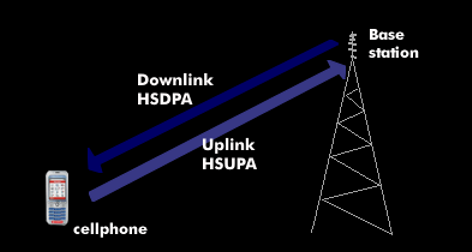high speed uplink packet access (HSPA) (HSUPA)
High Speed Uplink Packet Access (HSUPA) is a supplement to UMTS with which the Third Generation Partnership Project( 3GPP) increases the transmission rates for upstream in UMTS networks. At 1.0 Mbit/s to 1.5 Mbit/s, the data rates of HSUPA are lower than those of the downstream technology High Speed Downlink Packet Access( HSDPA). However, they can be increased to transmission rates of up to 5.76 Mbit/s using special techniques such as Enhanced Uplink (EUL), whose transmission channel is designated Enhanced Uplink Channel( EUCH).
HSUPA has an Enhanced Uplink Channel (E-DCH) for data with three additional signaling channels for the downlink that support HSUPA's increased data rate: In the E-HICH, E-DCH HARQ Indicator Channel, the transmission from the UMTS handset in the E-DCH is confirmed to. The E- AGCH, E-DCH Absolute Grant Channel, shows the UMTS mobile station the possible data rate in the uplink and the permitted transmission power. The uplink data rate can be increased or reduced via the third signaling channel, E-RGCH, which stands for E-DCH Relative Grant Channel.
The aim of HSPA activities is to combine the two services HSDPA and HSUPA in UMTS networks. This would make it possible to implement applications that require high data rates in both transmission directions, such as video conferencing or e-mails with large attachments.
In general, HSDPA and HSUPA require corresponding UMTS cell phones with data cards.

